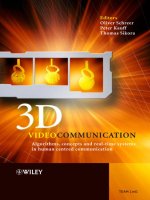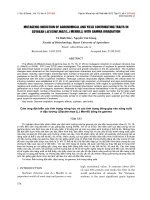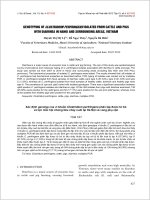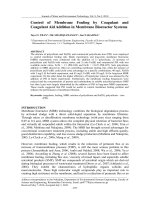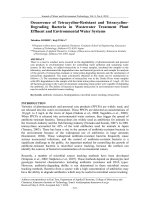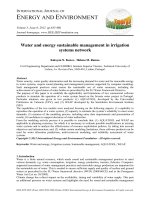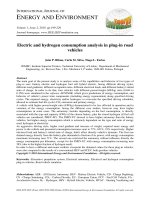- Trang chủ >>
- Khoa Học Tự Nhiên >>
- Vật lý
faith and place an essay in embodied religious epistemology jun 2009
Bạn đang xem bản rút gọn của tài liệu. Xem và tải ngay bản đầy đủ của tài liệu tại đây (984.2 KB, 280 trang )
FA ITH A ND P LAC E
This page intentionally left blank
Faith and Place
An Essay in Embodied
Religious Epistemology
MARK R. WYNN
1
3
Great Clarendon Street, Oxford ox2 6dp
Oxford University Press is a department of the University of Oxford.
It furthers the University’s objective of excellence in research, scholarship,
and education by publishing worldwide in
Oxford New York
Auckland Cape Town Dar es Salaam Hong Kong Karachi
Kuala Lumpur Madrid Melbourne Mexico City Nairobi
New Delhi Shanghai Taipei Toronto
With oYces in
Argentina Austria Brazil Chile Czech Republic France Greece
Guatemala Hungary Italy Japan Poland Portugal Singapore
South Korea Switzerland Thailand Turkey Ukraine Vietnam
Oxford is a registered trade mark of Oxford University Press
in the UK and in certain other countries
Published in the United States
by Oxford University Press Inc., New York
q Mark R. Wynn 2009
The moral rights of the author have been asserted
Database right Oxford University Press (maker)
First published 2009
All rights reserved. No part of this publication may be reproduced,
stored in a retrieval system, or transmitted, in any form or by any means,
without the prior permission in writing of Ox ford University Press,
or as expressly permitted by law, or under terms agreed with the appropriate
reprographics rights organization. Enquiries concerning reproduction
outside the scope of the above should be sent to the Rights Depar tment,
Oxford University Press, at the address above
You must not circulate this book in any other binding or cover
and you must impose the same condition on any acquirer
British Library Cataloguing in Publication Data
Data available
Library of Congress Cataloging in Publication Data
Library of Congress Control Number: 2009926736
Typeset by SPI Publisher Services, Pondicherry, India
Printed and bound in the UK
on acid-free paper by
MPG Biddles Ltd.
ISBN 978–0–19–956038–7
13579108642
For Christina, Storm, and Amber
This page intentionally left blank
Acknowledgements
I have been helped in this enquiry by many friends and colleagues.
I have beneWted especially from conversations with Tim Bartel, Stephen
R. L. Clark, John Cottingham, Tim Gibson, Brutus Green, David
Grumett, Chris Hamilton, Douglas Hedley, David Horrell, Rolfe
King, Louise La wrence, Da v e Leal, B rian Lefto w, A lastair Logan,
Morwenna Ludlow, John Masel, Tim Mawson, Jon Morgan, Rachel
Muers, John Ozolins, Esther Reed, Robert Roberts, Christopher
Southgate, Francesca Stavrakopoulou, and Richard Swinburne. My
thanks to all of you for suggestions that have helped to extend my
reading and thinking on these matters. I have also learnt from the
discussion of papers I have given at the Joseph Butler Society (Oxford
University, 2006), the D Society (Cambridge University, 2007), the
European Society for the Philosophy of Religion (Tu
¨
bingen, 2006),
the University of Durham research seminar in systematic theology
(2007), the University of Hertfordshire philosophy research seminar
(2007), the Christian Philosophy Conference (Allen Hall, 2007), the
Liverpool Hope U niv ersity conferenc e on ‘The Turn to Aesthetics’
(2007), the University of Zurich, Institute for Social Ethics conference
on ‘Emotions in Ethics and Religion’ (2008), and the research seminar
of the Department of Theology and Religious Studies, University of
Bristol (2008). I would also like to thank the students of my module
‘Contemporary Theologies of Place’ for their perceptive commentary
on many of the themes that I touch upon here. I am grateful, too, to
three anonymous referees for the Press for their guidance and encour-
agement, a n d to Tom Perridge, Elizabeth Robottom, Malcolm Todd,
and Charlotte Green for their thoroughness and good cheer. Taking a
longer view, I would also like to acknowledge here my Wrst helpers in
the philosophy of religion, Brian Davies and Richard Swinburne, whose
intellectual sensibility continues to inform, I like to think, what I write
and how I write. My friends at the Australian Catholic University have
also played their part in enabling the writing of this book – Australians
have particular cause to be interested in the possibility of a disciplined
appreciation of ‘the land’, and my years at ACU did much to sensitize
me to the questions that animate this enquiry.
I owe a very signiWcant debt of gratitude to several colleagues who
have provided extensive and particularly helpful comment on drafts
of the discussion – I am thinking here of Peter Byrne, Tim Gorringe,
and Mike Higton. Their remarks have led me to re-cast my approach
on a number of fundamental points – so I oVer special thanks to you!
I am also most grateful to the Arts and Humanities Research Council,
who generously funded my leave from normal duties for the period
October 2007 – January 2008. Without the assistance of the AHRC,
I would have written, at best, a diVerent and much inferior book. The
Council also provided a travel grant which enabled me to present
drafts of material for the book in Cambridge and Durham, and to
hold a number of very constructive conversations with David Brown,
John Inge, and Philip Sheldrake, during the autumn of 2007.
A key inspiration for this book has been the example of my
immediate predecessors in the Weld – in particular David Brown,
Tim Gorringe, John Inge, Belden Lane, and Philip Sheldrake. The
inXuence of all Wve of these authors will be evident in much of my
discussion, even where their work is not referenced explicitly – to
David I owe the idea, fundamental to my own project, that the
standard philosophical conception of ‘religious experience’ mig ht
be expanded, to allow for the materially mediated, place-relative
character of much religious experience; from John I have taken the
idea that the religious signiWcance of places is in various ways a
function of their past, as sites of divine disclosure; to Philip I owe
the thought that the identities of places are often contested, and have
a political dimension therefore; and from Belden Lane I have drawn
the conviction that it is possible to identify various ‘axioms’ for
understanding sacred place. I am also grateful to all of these writers
for the many examples of religiously meaningful places which they
have documented so amply and so ably – these case studies have
stamped my own sense of the integral connection between particular
places and a range of religious beliefs and practices. Finally, I would
like to oVer special thanks to my colleague Tim Gorringe, whose
writings and conversation on these themes have been an enduring
source of stimulus. If my treatment of the political dimension of
viii Acknowledgements
place in these pages is somewhat truncated, that is because these
matters have already been discussed so authoritatively in his work.
All of these considerations provide the intellectual context for my
reXections. There is also an important personal context deriving
from my friendship with the poet Edmund Cusick, but I will leave
the nature of this connection to emerge in the course of the discus-
sion. I am most grateful to Christina Crabtree-Cusick for permission
to quote from Edmund’s poems and other writings here.
Lastly, I oVer my heartfelt thanks to Kate and to Rowan who, in
their diVerent ways, have continued to take a lively interest in the
questions which I examine here. A central theme of this book is the
integral connection between religious ‘belief’ and an emotionally
resonant lived context – and one could make a similar sort of point
about the formal enquiry in which I am engaged here: it would have
no life but for the practical and emotional context prov ided by Kate
and Rowan. As always, I am grateful too to other family members for
their continued support – especially Mum and Dad, Rob and Sarah,
Gerard and Vania, Mark and Sue, together with John and Margaret
and the Australian wing of the family.
Acknowledgements ix
This page intentionally left blank
Copyright Acknowledgements
I am grateful to the editors of the following publications for the
opportunity to develop here themes that I Wrst explored there:
‘God, Pilgrimage, and Acknowledgement of Place’, Religious Studies
43 (2007), pp. 145–63.
‘Knowledge of Place and Knowledge of God: Contemporary Phil-
osophies of Place and Some Questions in Philosophical Theology’,
International Journal for Philosophy of Religion 62 (2007), pp. 149–
69.
‘Knowledge of God, Knowledge of Place, and the Aesthetic Dimen-
sion of Religious Understanding’, The Australian Ejournal of The-
ology 11 (2008), />theology/ejournal
‘Knowledge of God, Knowledge of Place, and the Method and Prac-
tice of the Philosophy of Religion’, in D. Cheetham and R. King,
eds., Contemporary Practice and Methods in the Philosophy of Reli-
gion: New Essays (London: Continuum, 2008), pp. 148–59.
I am also grateful for the opportunity to reproduce material from the
following sources:
Copyright 2006 by Wendell Berry from The Unforeseen Wilderness:
Kentucky’s Red River Gorge. Reprinted by permission of Counter-
point.
Erazim Koha
´
k, The Embers and the Stars: A Philosophical Inquiry into
the Moral Sense of Nature (1984). Permission granted by University
of Chicago Press.
This page intentionally left blank
Contents
1. The DiVerentiated Religious SigniWcance of Space
and Some Secular Analogues for Religious Knowledge 1
2. Friendship and Relationship to Place 17
3. The Supra-individuality of God and Place 44
4. The Grounding of Human Agency and Identity in
God and Place 71
5. Knowledge of Place 101
6. Pilgrimage and the DiVerentiated Religious SigniWcance
of Space 137
7. The Religious SigniWcance of Some Built and Natural
Environments 173
8. Knowledge of Place and the Aesthetic Dimension
of Religious Understanding 206
9. Some Concluding Thoughts 227
References 253
Index 263
The places which have meant most to me have always been
those places where I have felt on the edge of this world, places
where something mysterious has seemed nearby.
When I was very young primary school age the wood up
the lane at Bieldside had this feeling especially a little half
circle of trees against the North wall looking up towards the
farm, and to the Northern sky.
I could write, now, in almost any direction from that one
image of the wood. So much of my own life seems caught up
in it every corner of it having its own special, peculiar
atmosphere, an intensity of feeling which is partly me sensing
a magic, an innocence, a stillness, in the place itself, and partly
because, having been made aware of those deep layers of feeling
in myself by being alone there, the same place serves as a sure
route to bring them back.
(Edmund Cusick, from his blue notebook, December 2006/
January 2007)
Christianity . . .developed in a wider r eligious culture that assumed
human experience of the divine to be mediated through the body;
that utilized the body further to expr ess human divine relation;
and that understood human expectation of life to come in and
through bodily sensations. In each of these areas, it was the body as
a sensing and sensory entity that mattered.
(Susan Ashbrook Harvey, Scenting Salvation: Ancient
Christianity and the Olfactory Imagination, 2006, p. 223)
1
The DiVerentiated Religious SigniWcance
of Space and Some Secular Analogues
for Religious Knowledge
THE DIFFERENTIATED RELIGIOUS
SIGNIFICANCE OF SPACE
This discussion of the religious signiWcance of place is intended as an
exercise in philosophical theology. That comment might provoke a
degree of puzzlement. Of course, philosophical theologians have
wanted to aYrm that God is present in the world, and present at
particular places. But the notion of divine presence has typically been
articulated via the idea of God’s omni-presence – and that idea
suggests that, in certain fundamental respects anyway, God’s rela-
tionship to space is undiV erentiated. And doesn’t this show that
‘place’ cannot be a very interesting category for philosophical the-
ology? Thomas Aquinas makes the point with characteristic clarity:
‘God exists in everything by his power (inasmuch as everything is
subject to this), by presence (inasmuch as everything is naked and
open to his gaze), and by his essence (inasmuch as he exists in
everything causing its existence ).’1 A similar emphasis is evident
in the work of recent commentators. Richard Swinburne, for ex-
ample, represents God’s presence in the world as a function of his
1 Thomas Aquinas, Summa Theologiae 1a.8.3, in Brian Davies and Brian Leftow,
eds., Aquinas: Summa Theologiae, Questions on God (Cambridge, 2006), my em
phasis. See also Thomas’s comment that: ‘One approaches God, and one draws away
from him, not by bodily movement, since he is everywhere, but by movement of the
heart’: ibid., 1a.3.1.
power and knowledge – where this power and knowledge are of a
specially intimate kind, since they have no need of causal mediation.2
On this approach too, God is present in all places on the same basis,
since all regions of space are equally open to God’s knowledge and
sustaining activity.
While all of this may be true enough, it seems that there is at any
rate more to be said. As enacted, religious belief is after all, in many
ways, relative to place: the faithful seek out certain places for prayer,
they Wnd certain locations especially conducive to religious experi-
ence, and they undertake sometimes rather arduous journeys to sites
which are associated with Wgures of outstanding sanctity, or with
events which have played a deWning role in the formation of their
own tradition. All of these facts are overwhelmingly apparent from
even a cursory examination of the practices of believers, and all
would fall readily within the scope of an anthropological or socio-
logical appreciation of the phenomena of religious life. Yet it is
unclear, I suggest, how the diVerentiated religious signiWcance of
place that is manifest in so much religious belief and practice is to
be understood given the idea, aYrmed in the doctrine of divine
omnipresence, that God’s relationship to space is (in certain funda-
mental respects) uniform or free from diVerentiation.
It is not diYcult to see why philosophers have been reluctant to
pare down the doctrine of divine omnipresence. In the words of Luco
van den Brom, ‘the localizability of a divine being poses a constant
threat to his worthiness to receive worship’.3 And as Saint Anselm says,
it is ‘a mark of shameless impudence to say that place circumscribes
the magnitude of Supreme Truth’!4 So an adherent of the Abrahamic
faiths – of Judaism, Christianity, or Islam – will, evidently, want to
repudiate any suggestion that the diVerentiated religious signiWcance
of place implies that God is conWned by particular places. And
2 Richard Swinburne, The Christian God (Oxford, 1994), p. 127. Similarly,
he notes that divine omnipresence follows directly from divine omnipotence and
omniscience (p. 150).
3 Luco van den Brom, Divine Presence in the World (Kampen, 1993), p. 83.
4 Monologion , Chapter 20, cited in Edward R. Wierenga, ‘Omnipresence’, in Philip
Quinn and Charles Taliaferro, eds., A Companion to Philosophy of Religion (Oxford,
1997), p. 286. He gives as his source Saint Anselm: Basic Writings, tr. S. N. Deane
(La Salle, IL, 1962).
2 Faith and Place
upholding this perspective will require, no doubt, something like the
traditional doctrine of divine omnipresence.
But it is not suYcient, I am going to argue, to make do with a
merely psychological or pragmatic account of the diVerentiated
religious signiWcance of place – by saying , for example, that some
places are specially conducive to prayer just because they are quiet, or
that others are specially favourable for worship just because they
provide a large covered space and a good acoustic, or because it is
generally known that at 11 o’clock on a Sunday morning there w ill be
a minister here who is willing to lead a service! One recurrent theme
of this study will be, then, the insuYciency of purely psychological
accounts of diVerentiation in the religious signiWcance of place. To
see the implausibility of this sort of account, if taken to provide
a comprehensive view, it is perhaps enough to note for now – by
analogy – the inadequacy of a purely psychological account of the
rationale for visiting the grave of a loved one. This act is in part about
providing an occasion to recall the deceased person; but it also
matters to us, ver y often anyway, that we should be physically
alongside the remains of the dead person – and there is more to
standing in this relationship than simply thinking certain thoughts
or undergoing certain experiences. So in this connection, and in
other, more explicitly religious contexts, I shall argue, location mat-
ters independently of its implications for our mental life.
Another kind of account might seek to give a metaphysical rather
than psychological edge to the idea of diVerentiation in the religious
signiWcance of place, by recalling Aquinas’s remarks on the connec-
tion between God’s presence and God’s activity, and proposing that
God’s activity varies with place – especially in so far as this activity is
sometimes ‘miraculous’ or ‘direct’, that is, independent of the frame-
work of secondary or creaturely causality. If God’s causal relationship
to events is diVerentiated in this way, it might be said, then we can
allow for a correlative diVerentiation in the mode of God’s presence
(while still aYrming that God is everywhere present) – by supposing
that God is present in an especially intimate or ‘immediate’ way in
certain events, and in turn therefore in the places where those events
unfold. And it might be thought that this sort of account can provide
a rationale for some place-based religious practices. Why not sup-
pose, for example, that pilgrimage to a place such as Lourdes is
The DiVerentiated Religious SigniWcance of Space 3
grounded in the belief that miracles of healing are relatively likely to
occur here – so that the religious signiWcance of the shrine is relative
to the special character of God’s agency there?
As with psychologizing perspectives on the signiWcance of place,
I do not want to suggest that these ideas are of no interest for an
account of the religious meaning of place – but I do think that, even
when taken together, ‘psychological’ and ‘metaphysical’ approaches
fail to provide a comprehensive view. More exactly, I am going to
try to identify a kind of middle ground – one which roots the
diVerentiated religious signiWcance of place neither in some purely
psychological conception of the importance of place, nor in some
metaphysical claim about divine ‘intervention’ within the framework
of secondary causation. Intuitively, the plausibility of this middle
ground consists in the fact that when the believer assigns a special
religious signiWcance to a place, they need not suppose that being
at the place is at all likely to eVect some transformation in their
consciousness – and they need not think, therefore, that it is the
possibility of this sort of transformation which explains the place’s
religious importance; but equally, when they Wnd a place to be of
special religious signiWcance, the believer need not be committed
thereby to some metaphysical speculation concerning the ‘mechan-
ics’ of divine action at this place. There are analogies here with other
Welds of theological discussion. For example, we might well wish to
say that the signiWcance of the eucharist is not simply that of a
memorial meal (the psychologistic reading of the meaning of the
practice) – but equally it is not dependent upon the truth of some
speculative (and perhaps as yet unformulated) account of the meta-
physics of divine action at the moment of consecration.
THE USE OF SECULAR ANALOGIES
FOR RELIGIOUS BELIEF
So here is one intellectual context for the present work: I am inter-
ested to see how the doctrine of divine omnipresence might be set
within some larger theoretical framework which gives proper
4 Faith and Place
recognition (one that is neither psychologically reductionist nor
metaphysically overbearing) to the place-relative character of reli-
gious belief and practice. A second intellectual context is provided
by recent work in analytic religious epistemology. This tradition of
enquiry has for some time been occupied with the fruitfulness
of various secular analogies for religious knowledge. (For ease of
reference, I shall continue to talk of ‘knowledge’ here, but others
may prefer to substitute some other epistemic success term – and
this should not disturb the main thread of the argument.) For
example, some writers have thought that knowledge of God is akin
to scientiWc knowledge – since both kinds of knowledge involve the
postulation of an entity which is not itself obser ved but which can
help to explain the data of observation. Providing that it satisWes
criteria such as simplicity and predictive power, so the argument
runs, a postulate of this kind will count as a good explanation; and
reference to God generates, therefore, a powerful account of certain
structural features of the universe, such as its conformity to natural
law – where ‘explanatory power’ is deWned by the same standards of
theory construction as obtain in the natural sciences. Richard
Sw inburne’s writings provide the most detailed and, justly, the
most celebrated working out of this approach to the epistemology
of religious belief.5
Other commentators have given a larger role to the idea that
religious experience is analogous to ordinary perceptual experience –
so that religious knowledge has an epistemic status which is broadly
comparable with that of our everyday perceptual knowledge of the
material world. William Alston, for example, has argued that certain
objections to the epistemic worth of religious experience, if applied
consistently, would have, equally, a tendency to impugn the trust-
worthiness of ordinary perceptual experience. This is, he suggests, a
case of ap plying ‘double standards ’ – of holdi ng religious experience
accountable to a more exacting set of requirements than we would
deem Wtting in the context of ordinary sense experience.6
5 See especially Richard Swinburne, The Existence of God (2nd edn, Oxford, 2004).
6 See William Alston, Perceiving God: The Epistemology of Religious Experience
(Ithaca, NY, 1991), Chapter 6. It is worth noting that Swinburne also oVers an
argument from religious experience: The Existence of God, Chapter 13.
The DiVerentiated Religious SigniWcance of Space 5
Of course, Alston’s case is not straig htforwardly an argument for
the idea that religious and ordinary perceptual experience are analo-
gous; he is also keen to emphasize that on certain points the two are
answerable to diVerent epistemic standards. Otherwise, he suggests,
we will fall into ‘epistemic imperialism’ – allowing one mode of
experience, and its associated doxastic or belief-forming practices,
to determine the epistemic standards which apply to experience in
general. And we know from everyday sensory contexts that this is not
appropriate – we would not, for instance, apply the same standards
to the discrimination of the Wner gustatory properties of a wine and
the identiWcation of the large-scale structural properties of a table.
Nonetheless, Alston’s project can be seen to form part of this broadly
deWned trend in recent philosophy of religion to ground the epi-
stemic status of religious belief in analogies drawn from other epi-
stemic contexts. (Even his criticism of ‘epistemic imperialism’, with
its recognition of the sui generis character of religious experience in
certain respects, rests more broadly upon an appeal to the domain of
sensory experience, in so far as our appreciation of the inappropri-
ateness of over-generalizing accounts of the grounds for belief derives
from our practice within this domain – as when we distinguish
between beliefs about wines and about tables.)
These strategies, whether rooted in scientiWc or perceptual analo-
gies, make obvious apologetic sense – since they trade on the evident
fact that ordinary sensory beliefs and scientiWc beliefs enjoy, for most
of us anyway, a certain epistemic prestige. But whatever their merits
in this respect, both strategies have a tendency to break the connec-
tion between religious knowledge and our embodied and practical –
including here our ethical and aesthetic – engagement with the
material world. The Wrst strategy represents religious knowledge as
the product of a quasi-scientiWc inference. It should be said that
Sw inburne’s formulation of this approach actually turns on a sharp
distinction between ‘personal’ and ‘scientiWc’ modes of explanation –
and he holds, of course, that theistic explanation is ‘personal’.
In general terms, his argument is that some features of the universe
are in principle scientiWcally inexplicable (for example, its large-scale
structure, or the very fact of its scientiWc intelligibility). Even so, he
maintains, these features call for explanation of some kind – and
6 Faith and Place
since there are in general only two varieties of explanation, the
personal (which deploys the notions of belief and intention) and
the scientiWc (which appeals to natural regularity), we must therefore
have recourse, in these cases, to a personal explanation. Nonetheless,
Sw inburne still assimilates religious belief to a quasi-scientiWc infer-
ence in so far as he thinks that theistic explanation is properly
accountable to the criteria which regulate theory construction in
science – especially simplicity and predictive power.
So here religious knowledge is represented as an inference – one
which starts from observation of general structural features of the
world, and then carries the mind away from the material order to the
non-material, unobserved God who is postulated as its source. Such
an approach is disconnected from our practical engagement with the
material world in various respects: it is concerned not with speciWc
environments, or ‘places’, and our embodied interaction with them,
but with general structural features of the universe of the kind
disclosed in, for example, cosmology; it turns upon an inference of
an abstractly theoretical kind; and the explanans which it postulates,
namely God, is taken to be a non-material entity, whose character
and powers can be speciWed, in general terms, independently of any
reference to what is revealed in our experience of the material world.
Alston’s kind of approach also seems to be disconnected, in
fundamental respects, from our practical knowledge of the world.
For the most part, he is concerned with religious experience con-
ceived as a non-sensory encounter with God – and an experience of
this kind will bypass our material context altogether.7 In fairness, we
should add that Alston acknowledges the possibility of ‘indirect
perception’ and ‘indirect recognition’ of God, where God is perceived
or recognized in (rather than being inferred from) the data of sense
observation – rather as we might indirectly perceive someone when
we see a television image of them, or indirectly recognize an aero-
plane in a vapour trail, even if we cannot make out the plane itself.8
Nonetheless, by taking ‘direct’, non-sensory perception of God as the
focus of his discussion, Alston inevitably deXects attention away
7 Alston sets out the idea of non sensory experience in Perceiving God, pp. 14 20.
8 Alston gives these examples in Perceiving God, p. 21. He notes the possibility of
religious parallels for both cases on p. 28.
The DiVerentiated Religious SigniWcance of Space 7
from the material context of religious experience;9 and his preference
for thinking of other kinds of religious experience by analogy with,
say, seeing a television image or a vapour trail invites the thought that
even in cases of ‘indirect’ perception or recognition, God is known
simply by looking, rather than by virtue of our moral, aesthetic and
otherwise engaged response to the material world.
I noted above that I did not want so much to reject psychologizing
or metaphysical accounts of the diVerentiated religious signiWcance
of place, as to question their capacity to provide a comprehensive
view. Similarly, I do not wish to deny the worth of scientiWc and
perceptual analogies for religious knowledge. In fact, the disciplined
unfolding of both analogies in recent discussion has helped to throw
various features of the epistemology of religious belief into new
and helpful relief. However, I do think that both strategies have a
tendency to occlude the connections between religious knowledge
and our practical, engaged knowledge of the material world. So a
further aim of the present volume is to consider how this connection
might be articulated in theoretical terms.
THE ANALOGY BETWEEN KNOWLEDGE OF
GOD AND KNOWLEDGE OF PLACE
For this purpose, I am going to rely upon another secular analogy –
by thinking of knowledge of God as analogous to knowledge of
place. Knowledge of place consists, at least in part, in an embodied,
practical and, very often, theoretically inarticulate responsiveness to
a given region of space. So to this extent, knowledge of place w ill of
course form a more promising starting point for an account of
knowledge of God if our concern is to bring into clearer view the
relationship between knowledge of God and our practical, engaged
knowledge of the world. But on behalf of the other perspectives
9 Alston notes this decision in Perceiving God, p. 28. He also shows some reluctance to
give a substantive epistemic role to emotional feelings in religious experience which
again suggests a tendency to abstract from the embodied character of such experience
(see pp. 49 50).
8 Faith and Place
I have mentioned – those rooted in scientiWc or perceptual analogies –
it might be wondered why we should suppose that there is any such
connection. This book is intended to constitute one extended res-
ponse to this question, but in brief my approach is bound up with the
belief that knowledge of God, in the theologically or religiously
interesting sense, involves a commitment of the person in their
aVective-practical-cognitive integrity. One might in a purely inferen-
tial way, or perhaps by means of some non-sensory intuition, come to
form the belief that there is a God, without this belief carrying any
implications for one’s behaviour. But ‘belief’ of this kind, shorn of
any consequences for one’s life practically and aVectively, is not what
is standardly meant by ‘belief’ in the religious context.10
Peter Winch makes this sort of point when he comments that
ceasing to pray is more like an aspect than it is like a consequence of
ceasing to believe in God. By contrast, my ceasing to address letters to
the Yugoslav ambassador, he notes, is naturally viewed as a conse-
quence (and not an aspect) of my ceasing to believe that there is such
an individual.11 Here Winch is proposing that when we ascribe a
religious belief to someone we are not, in the normal case, attributing
to them some purely theoretical belief – that is, a belief which is not
of itself action-guiding or in some other way implicated in activities
such as prayer. By contrast, I could very well believe that there is
a Yugoslav ambassador without this belief carrying any implications
for my life from a practical point of view. And this is why ceasing to
write to the ambassador can count as a ‘consequence’ of giving up
the belief that there is an ambassador – because the belief in this case
has the requisite logical independence from the practice to allow
10 For a further attempt to provide an existentially ‘denser’ characterization of
the notion of ‘belief’ as it operates in religious contexts, one that I have found
particularly helpful, see John Cottingham’s proposal that ‘character’ is relevant to
the epistemology of religious belief, and his related suggestion that religious belief
can be grounded in the recognition of moral and aesthetic ‘traces’ of God, rather than
in some supra sensory experience: The Spiritual Dimension: Religion, Philosophy
and Human Value (Cambridge, 2005), Chapter 7. For a further perspective which
also stands in distinction from Alstonian and Swinburnean kinds of approach, see
Douglas Hedley’s instructive defence of a contemporary form of Christian Platonism
in Living Forms of the Imagination (London, 2008).
11 Peter Winch, ‘Meaning and Religious Language’ in Stuart Brown, ed., Reason
and Religion (Ithaca, NY, 1977), pp. 207 8.
The DiVerentiated Religious SigniWcance of Space 9
a change in the practice to count as a consequence, rather than
simply an ‘aspect’, of a change in belief.12
This issue is connected with another. There are two standard
routes into the subject matter of philosophical theology or the
philosophy of religion. As we have seen, one route is epistemological:
we can start by asking ourselves about the grounds and status of
religious knowledge claims. The other route begins, rather, with the
content of religious belief – by asking about what we should under-
stand by ‘God’ or ‘the sacred’ otherwise conceived. Of course, these
two routes are typically mutually deWning – a given epistemology of
religious belief will standardly issue in a certain view of the ‘object’ of
religious belief, and vice versa. For example, Aquinas’s First Way lays
down one account of the epistemic basis of belief in God – seeing
such belief as derivable from the need to explain change. But this
strategy also commits us, in his judgement, to a certain conception
of God – as changeless, and in turn therefore as immaterial and
impassible. Similarly, though inversely we might suppose, Anselm
begins from a conception of God, as ‘that than which nothing greater
can be conceived’, and on the basis of this conception, he goes on to
provide a set of reasons for supposing that God cannot but exist.13
This connection between religious epistemology and the concept
of God also holds in broad terms, I think, when we consider the
secular analogies for knowledge of God that have been proposed by
Sw inburne, Alston, and others. If we postulate God in rather the way
that we postulate an electron, in order to explain the data of obser-
vation, or if we suppose that in religious experience we encounter
12 Although I shall not explore the connections here, the perspective defended in
this book could easily be aligned with recent feminist epistemology. See for example
the concern for questions of ‘place’ and embodied practice that is apparent in
Lorraine Code’s remark that: ‘In their commitment to honouring complexity, ecofe
minism and ecological thinking require sensitivity to detail, to minutiae, to whatever
precisely. . . distinguishes this woman, this contestable practice, this social interven
tion, this place, this problem of knowledge, this injustice, this locality from that’:
Lorraine Code, Ecological Thinking: The Politics of Epistemic Location (Oxford, 2006),
pp. 17 18. For a clear account of how feminist perspectives might be brought to bear
on questions in the epistemology of religion in particular, see Pamela Sue Anderson,
‘An Epistemological Ethical Approach’, in Pamela Sue Anderson and Beverley Clack,
eds., Feminist Philosophy of Religion: Critical Readings (London, 2004), pp. 87 102.
13 See respectively Summa Theologiae 1a.2.3 and 1a.3, and Proslogion, Chapters 2 3.
10 Faith and Place
